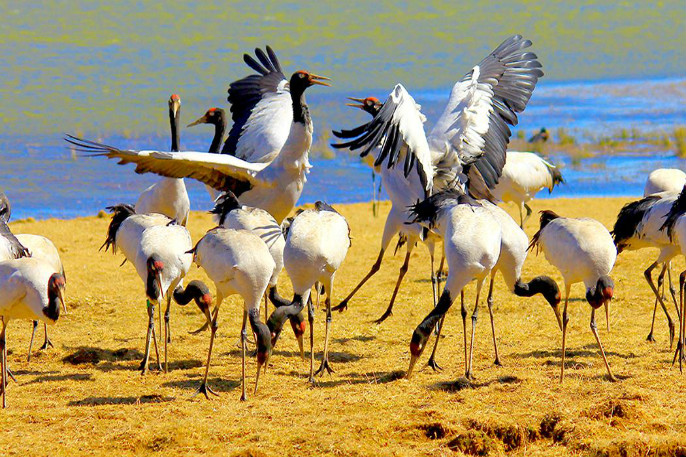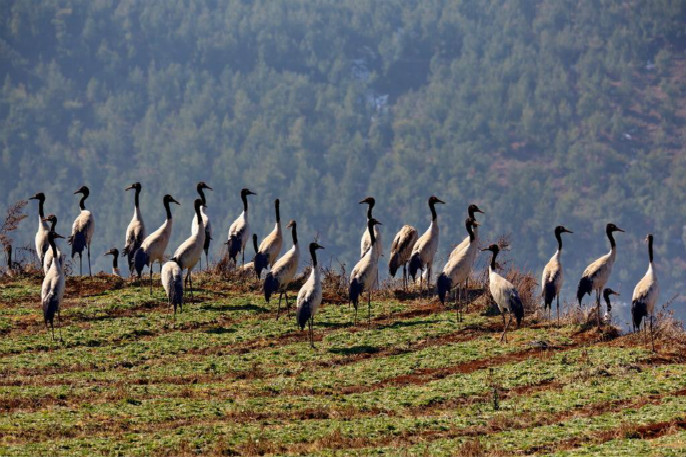
Black-necked cranes in Yunnan
“Black-necked crane, the only crane living on plateau area in China, is one of the latest discovered cranes. As a species under first class national protection and a kind of bird in urgent need of global salvation, the crane is listed in the Convention on International Trade in Endangered Species of Wild Fauna and Flora. About 800 black-necked cranes migrate to Northeast Yunnan’s Huize Country every winter, making Huize one of the globally largest wintering sites for black-necked cranes.

November ushers in the best bird watching season at Nianhu lake in Huize. It takes over one hour to reach Nianhu lake from the country along mountain road. At sunrise every day, you can see a lively and boisterous scene in the roost site of black-necked cranes in Nianhu lake: Some cranes are dozing with heads buried in their bodies, others are taking off from the lake. In the next couple hours, all the birds fly away one family after another forage. A typical black-necked crane family usually consists of two adult cranes and one or two nestlings. Before night falls, the crane return to the roost site in groups and spend the night altogether. Workers in the black-necked cranes administration have to check the number of them every day at the roost site, which is the best monitoring site in the early morning.
At noon, on the waterfront of Nianhu Lake and adjacent ploughed land, white figures are visible from a distance. When the monitor zooms in, we can see the black-necked cranes stand or sit side by side in groups of two or three, foraging with heads lowered. They are not as “black” as are imaged. Being tall and slim, they boost straight and slender legs. When standing, they raise their necks high. They have yellow beaks which are sharp enough to cut potatoes. They are white all over the body, except the black heads, necks, tails and feet. Their eyes are only visible with the help of the indicative white spots right under their eyes. An adult black-necked crane’s body is generally 1.2 meters long and about 5 kilograms in weight.
Cranes generally live in the plain areas, but black-necked cranes live on plateaus which is not an ideal habitat for them. “Black-necked cranes can be counted as an endemic species to China, and only a few can be found abroad.” said Huam Guoyue, Director of Huize National Black-necked Crane Conservation Administration. Black-necked cranes are mainly distributed in the plateau areas with an elevation of 2,000-5,000 meters, such as Yunnan, Guizhou, Sichuan, Qinghai, Gansu, Xinjiang and Tibet. Huize, Zhaotong, Napahai in Yunnan and Weining in Guizhou are their wintering areas; Qinghai, Gansu, Xinjiang and Tibet are their breeding places. From the mid-to-end of April to October, they live in the breeding places. In October, they leave Qinghai and Tibet for places in Yunnan to overwinter. The places where they set out are over 3,000 meters above the sea level, and the straight-line distance to the destinations is 700-800 km. From the mid-to-end of October to April, black-necked cranes live in wintering areas. Huize residents have summarized their migratory flight time in a rhymed Chinese phrase : “ The cranes come on around September 9 and leave around March 3 according to lunar calendar.”
Black-necked cranes congregate relatively closer on wintering areas. The now-gregarious species still show obvious groups of three or two birds though, which “are usually families".
Black-necked cranes in Huize manifest another behavior: they intermingle with other birds. As shown in a photo taken by HuanGuoyue, a flock of black-necked cranes and a flock of Grey cranes stay in the same place harmoniously with each other. “Black-necked cranes, bar-headed gooses, ruddy shelducks and yellow ducks are also found to coexist in one place. Sometimes they chase each other, but more often they live together in peace. The heterogeneous community may be attributed to similar habits.”

Attractive of Nianhu Lake
Apart from the ample food supply, what other natural conditions of Huize attract black-necked cranes to come for wintering ? According to local residents, “As plateau birds, black-necked cranes need habitats with higher elevation. Being 2,490-2,900 meters high above sea level, Nianhu lake satisfies the altitude demand of black-necked cranes.” In addition, a large water area is necessary. In spite of the cold climate, the surface of Nianhu lake will not freeze in winter. Meanwhile, Nianhu lake and the surrounding marsh wetland provide sufficient source of water for black-necked cranes’ inhabitation. In plateau areas, the reason for the forming of marsh wetland are complicated. First of all, there should be sufficient source of water. When moisture stagnates on the earth’s surface, sufficient water supply will take shape. The impermeable sediment in the soil will prevent the moisture from infiltration, and eventually a marsh is formed. Nianhu Lake has adequate source of water from massif rivers. The annual precipitation of the lake is over 800 millimeters. As Nianhu Lake is located in a basin, the surrounding mountains block atmospheric circulation, creating plenty of rainfall and mist. The fine granulated clay particles at the bottom of the lake basin obstruct the permeation of underground water. What’s more, the cold climate of plateau keeps a lower rate of evaporation, which ensures the balance between water supply and water loss.
Black-necked cranes are nostalgic for old habits, but not without strict requirement. “After the water level of the reserve rises, the original place where birds inhabited in the lake will be submerged. If people do not construct a bird island in time,black-necked cranes will find their living environment tampered when they come, and they will not come back the following year” said Local people.

Landform of the reserve
The habitat of black-necked cranes in Huize is kind of surprising. Although both Changhaizi and Daqiao belong to Huize Black-necked cranes Natural Reserve, they have far cry land-forms. Daqiao area is dominated by wet land, while Changhaizi mainly consists of dry land and cultivated land. Black-necked cranes are distributed in both of the two areas. “Many researchers are puzzled by the dichotomized environments and the birds’ habits in one reserve, which sets our reserve apart from others.”
Another difference between the two areas: Changhaizi area is sparsely populated by people, while Daqiao area is full of human activities. In Daqiao, local residents can make close contact with black-necked cranes. “Black-necked cranes are highly vigilant, but get along with people well in harmony here. Sometimes the cranes forage behind the ploughing people.” The black-necked cranes’ close contact with the local people does not mean that they are less vigilant altogether. “Black-necked cranes are rather vigilant against tourists and strangers, who can frighten them away when they approach within twenty or thirty meters away. The cranes can be scared even by a single movement of tourists.”
Huan Guoyue said, “From the perspective of national reserves, people are not allowed to walk about in the reserve. Nevertheless, the circumstances of Daoqiao are special that residents had been living here for generations prior to the later wintering of black-necked cranes .” In Huan Guoyue’s opinion, this is precisely why black-necked cranes choose to overwinter here. They would not have picked this place, had it not been for the crops planted by people that provide them with food.”
A watcher of Black-necked cranes
On October 15, HuanGuoyue recorded on his wechat( a well known social network forum in China): “Four Grey cranes have come today, and black-necked cranes will come home soon. The wetland environment is pretty favorable this year, and food is more than enough.” On October 26, the arrival of the first spearhead flock of black-necked cranes delighted Huan Guoyue a lot. “Today six black-necked cranes are found to be back in Huize, and the majority of them will follow in the days down the road.”
Since his participation in the first scientific investigation of black-necked cranes in Huize in 1986, Huan Guoyue has been occupied in the protection and research of this species in the area for nearly 30 years. He still remembers the day when he saved the first black-necked cranes in 1980s. On that heavy foggy day, Huan Guoyue found an injured black-necked cranes in Chang haizi. He thought the crane may have had hit a pole in the dense fog. The injured crane was so vigilant that it took several people to catch it. They covered its head with a black sack and took it home. “At that time, no information whatsoever was available, so we just fumbled all the way. After we took the injured crane back, I got help from the Bureau of Animal Husbandry, who gave the bird intravenous drip injection to bring it back to life.”
At present, to keep abreast of the developments of the reserve, Huan Guoyue does not need to go there in person. With modern geographic information system (GIS) established in the reserve, he can see everything as long as the monitor of the black-necked cranes is uploaded. A mature monitoring system is also established in the reserve, so everyone can see the real-time developments of the black-necked cranes in Huize as long as he or she logs on the official website. Huan Guoyue is proud of that, and he teaches his friends step by step how to enter the monitoring system and watch black-necked cranes from a distance in his wechat.
On a spring day last year, when Huan Guoyue made “routine observation” on the reserve website as usual, he found the black-necked cranes starting to migrate, feeling a bit saddened. Suddenly, he spotted something unusual, he found the black-necked cranes starting to migrate, feeling a bit saddened. Suddenly, he spotted something unusual that puzzled him: two black-necked cranes did not follow the flying team. “In general, black-necked cranes fly together as a team.”. He immediately zoomed in the monitor and found that one of the cranes seemed to have a leg broken. Another crane in good health accompanied the injured one all along. Migration would be a strenuous flight for a crane with a broken leg, so Huan Guoyue had his workers to feed them every day. The two cranes stayed together for a dozen of days till the injured crane looked almost recovered. One day, after ten o’clock am, the two cranes took off, made a circle in the sky and flew away. “They may be a couple. Legend has it that black-necked cranes are monogamous. In the black-necked group, a crane that has lost its spouse is called a ‘lone crane’. Lonely cranes often take the role of sentries. They make birdcalls when faced with danger, to warn other black-necked cranes. Local residents have thus developed a strong conscience of protecting lonely cranes.”
You can check more information from our website , for itinerary and travel guide in Huize for black-necked cranes. And contact us for birdwatching trips.